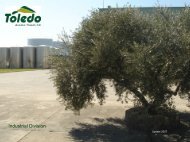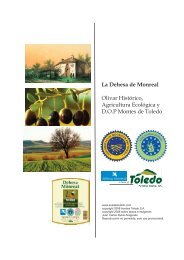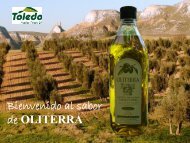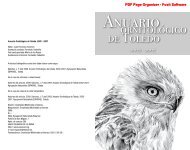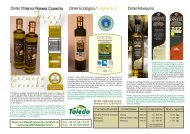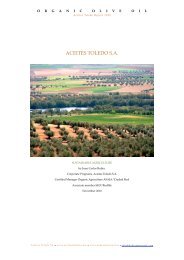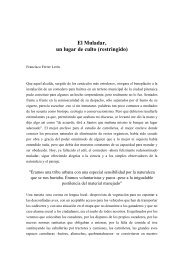On Olive Oil History and Facts. - Aceites Toledo SA
On Olive Oil History and Facts. - Aceites Toledo SA
On Olive Oil History and Facts. - Aceites Toledo SA
You also want an ePaper? Increase the reach of your titles
YUMPU automatically turns print PDFs into web optimized ePapers that Google loves.
<strong>Olive</strong> <strong>Oil</strong> <strong>History</strong> <strong>and</strong> <strong>Facts</strong><br />
Sinolea<br />
Page 14<br />
This is the most recent method to extract oil from the olives, rows of metal discs or plates are<br />
dipped into the paste; the oil preferentially wets <strong>and</strong> sticks to the metal <strong>and</strong> is removed with<br />
scrapers in a continuous process. It’s based on the different surface tension of the vegetation<br />
water <strong>and</strong> the oil, these different physical behaviors allow the olive oil to adhere to a steel plaque<br />
while the other two phases stay behind.<br />
Sinolea works by continuously introducing several hundreds of steel plaques in to the paste thus<br />
extracting the olive oil. This process is not completely efficient leaving a large quantity of oil still<br />
in the paste, so the remaining paste has to be processed by the st<strong>and</strong>ard modern method<br />
(Industrial Decanter).<br />
Advantages <strong>and</strong> Disadvantages<br />
Advantages<br />
Higher polyphenol content of oil<br />
Low temperature method<br />
Automated<br />
Low labor<br />
<strong>Oil</strong>/water separation step is not needed<br />
Low energy requirement<br />
Disadvantages<br />
Often must be combined with one of the above methods to maximize oil extraction which requires<br />
more space, labor, etc.<br />
Large surface areas can lead to rapid oxidation<br />
Sale of future machines currently outlawed in European Union due to difficulty with cleaning such<br />
large surface areas.<br />
First Cold Pressed – Cold Extraction<br />
Many oils are marketed as first cold pressed or cold extraction, this is a denomination describing<br />
the temperature at which the oil was obtained. Since most olive stone mills have disappeared in<br />
the world, the correct expression should be “extraction”, instead of “pressing”. In the European<br />
Union these designations are regulated by article 5 of Regulations 1019 of 2002. This article<br />
states that in order to use these designations the olive oil bottler must prove that the temperature<br />
of Malaxation <strong>and</strong> Extraction was under 27ºC (80ºF).<br />
For olive oil bottled outside EU countries this regulation does not apply, <strong>and</strong> therefore the<br />
consumer has no assurance that these statements are true. The temperature of malaxation <strong>and</strong><br />
extraction is crucial due to its effect on olive oil quality. When high temperatures are applied the<br />
more volatile aromas are lost <strong>and</strong> the rate of oil oxidation is increased, producing therefore lower<br />
quality oils. In addition, the chemical content of the polyphenols, antioxidants, <strong>and</strong> vitamins<br />
present in the oil is reduced by higher temperatures. The temperature is adjusted basically by<br />
controlling the temperature of the water added during these two steps. High temperatures are<br />
used to increase the yield of olive oil obtained from the paste.



